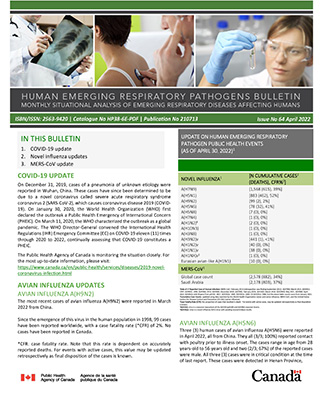Human emerging respiratory pathogens bulletin: Issue 64, April 2022
Download in PDF format
(1.1 MB, 3 pages)
Organization: Public Health Agency of Canada
Date published: 2022-05-10
In this bulletin
- COVID-2019 update
- Avian influenza updates
- Swine influenza updates
- Middle East respiratory syndrome coronavirus (MERS-CoV) update
| Novel influenzaTable 1 Footnote 1 | Cumulative Case CountTable 1 Footnote 2 | Deaths | Case Fatality Rate %Table 1 Footnote 3 |
|---|---|---|---|
| A(H7N9) | 1,568 | 615 | 39% |
| A(H5N1) | 883 | 462 | 52% |
| A(H9N2) | 99 | 2 | 2% |
| A(H5N6) | 78 | 32 | 41% |
| A(H5N8) | 7 | 0 | 0% |
| A(H7N4) | 1 | 0 | 0% |
| A(H1N2)Table 1 Footnote 4 | 2 | 0 | 0% |
| A(H10N3) | 1 | 0 | 0% |
| A(H3N8) | 1 | 0 | 0% |
| A(H3N2)v | 441 | 1 | <1% |
| A(H1N2)v | 40 | 0 | 0% |
| A(H1N1)v | 38 | 0 | 0% |
| A(H1NX)vTable 1 Footnote 5 | 1 | 0 | 0 |
| Eurasian avian-like A(H1N1) | 10 | 0 | 0% |
| MERS-CoVTable 1 Footnote 1 | Cumulative Case CountTable 1 Footnote 2 | Deaths | Case Fatality Rate %Table 1 Footnote 3 |
| Global Case Count | 2,578 | 882 | 34% |
| Saudi Arabia | 2,178 | 803 | 37% |
|
|||
COVID-19 update
On December 31, 2019, cases of a pneumonia of unknown etiology were reported in Wuhan, China. These cases have since been determined to be due to a novel coronavirus called severe acute respiratory syndrome coronavirus 2 (SARS-CoV-2), which causes coronavirus disease 2019 (COVID-19). On January 30, 2020, the World Health Organization (WHO) first declared the outbreak a Public Health Emergency of International Concern (PHEIC). On March 11, 2020, the WHO characterized the outbreak as a global pandemic. The WHO Director-General convened the International Health Regulations (IHR) Emergency Committee (EC) on COVID-19 eleven (11) times through 2020 to 2022, continually assessing that COVID-19 constitutes a PHEIC.
The Public Health Agency of Canada is monitoring the situation closely.
Avian influenza updates
Avian influenza A(H9N2)
The most recent cases of avian influenza A(H9N2) were reported in March 2022 from China.
Since the emergence of this virus in the human population in 1998, 99 cases have been reported worldwide, with a case fatality rate (*CFR) of 2%. No cases have been reported in Canada.
*CFR: case fatality rate. Note that this rate is dependent on accurately reported deaths. For events with active cases, this value may be updated retrospectively as final disposition of the cases is known.
Avian influenza A(H5N6)
Three (3) human cases of avian influenza A(H5N6) were reported in April 2022, all from China. They all (3/3; 100%) reported contact with poultry prior to illness onset. The cases range in age from 28 years-old to 56-years old and two (2/3; 67%) of the reported cases were male. All three (3) cases were in critical condition at the time of last report. These cases were detected in Henan Province, Jiangsu Province, and Sichuan Province. None of the cases were known to be connected to each other or to previously reported cases.
A total of 78 laboratory-confirmed human cases of avian influenza A(H5N6), including at least 32 deaths (CFR: 41%) have been reported globally since 2014. Since January 2021, 52 cases of avian influenza A(H5N6) have been reported globally (Figure 2); 51 A(H5N6) cases were reported from China and one (1) case was reported from Lao PDR (Figure 3). So far, 20 A(H5N6) cases have been reported worldwide in 2022. No cases have been reported in Canadian residents.
Avian influenza A(H3N8)
In April 2022, the National Health Commission of the People's Republic of China reported the first known human infection with A(H3N8) ever. The case, a 4 year-old male living in Henan Province, had an illness onset date of April 5th. The case was hospitalized on April 10th. The case had contact with chickens and wild ducks that were around the home. At the time of reporting, none of the case’s close contacts have tested positive for A(H3N8). This is the first A (H3N8) case ever reported worldwide. No cases have been reported in Canadian residents.
Avian influenza A(H5N1)
In April 2022, the United States Centers for Disease Control and Prevention (CDC) reported a human case of avian influenza A(H5N1) virus. The case, a person >18 years of age living in Colorado, was exposed to H5N1-infected birds while participating in poultry depopulation activities. The case’s only reported symptom was fatigue, which resolved after 3 days. This is the first human case of avian influenza A(H5N1) virus in the U.S.
The second most recent human case of avian influenza A(H5N1) was reported in January 2022 out of the United Kingdom. The case was over 70 years old, asymptomatic, and was non-infectious at the time of reporting. The case was exposed to A(H5N1) via infected domestic birds kept on the residence prior to illness onset. The birds were culled and the case was tested out of precaution. No onward transmission of the virus was identified through case contact follow-up.
There have been 883 human cases of A(H5N1) reported globally since 1997, with a CFR of 52%. No domestically acquired A(H5N1) infections have ever been reported in Canada. One (1) A(H5N1) case has been reported worldwide in 2022. In 2014, Canada (Alberta) reported one single fatal case of A(H5N1) in a resident returning from travel in China.
Swine influenza updates
Swine origin influenza A(H1N2)v
The most recent case of swine origin influenza A(H1N2)v was reported in February 2022 from the US.
A total of 40 A(H1N2)v cases have been reported globally since 2005, with a 0% case fatality rate. One (1) A(H1N2)v case has been reported worldwide in 2022. Three (3) A(H1N2)v detections have been reported in Canadian residents since reporting began in 2005, and the latest case in Canada was reported in November 2021 from Manitoba.
Swine origin influenza A(H3N2)v
The most recent case of swine origin influenza A(H3N2)v was reported in October 2021 from the US.
Globally, 441 A(H3N2)v cases have been reported since 2005, with <1% case fatality rate. No A(H3N2)v cases have been reported worldwide in 2022. Two (2) A(H3N2)v detections have been reported in Canadian residents since reporting began in 2005, with the latest case reported in June 2021.
Swine origin influenza A(H1N1)v
The most recent case of swine origin influenza A(H1N1)v was reported in January 2022 from Denmark.
Globally, 38 human cases of A(H1N1)v have been reported since 2005, with no associated fatalities. One (1) A(H1N1)v case has been reported worldwide in 2022. Two (2) A(H1N1)v detections have been reported in Canadian residents since reporting began in 2005, with the latest case reported in April 2021.
Swine origin influenza A(H1NX)v
In November 2021, one (1) human infection with a novel influenza A(H1NX)v was reported in the US. The case, ≥18 years of age and living in Oklahoma, was hospitalized for an unrelated illness and was discharged. The case reported contact with swine at home and at an agricultural event prior to specimen collection. No ongoing human-to-human transmission was identified in association with this case. There has been no confirmation on the neuraminidase subtype.
Figure 1. Spatial distribution of human cases of avian and swine influenza reported globally in April 2022 (n=5).
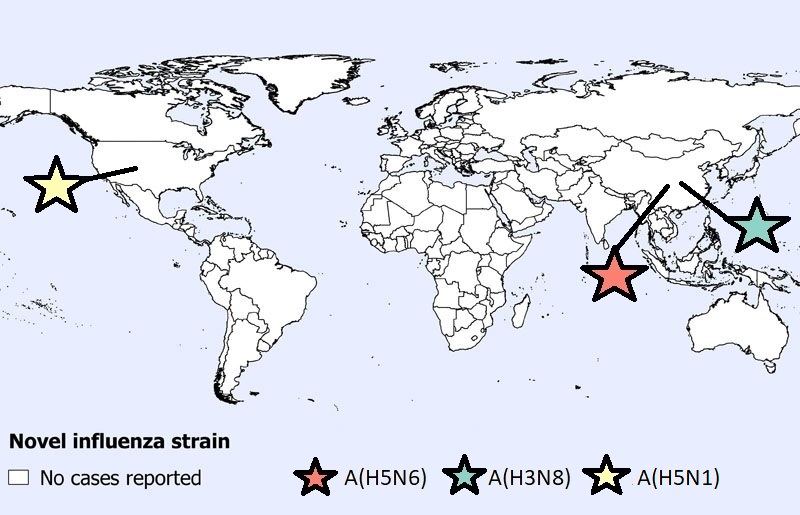
Note: Map was prepared by the Centre for Immunization and Respiratory Infectious Diseases (CIRID) using data from the latest WHO Event Information Site (EIS) postings and Weekly US Influenza Surveillance Reports (FluView). This map reflects data available through these publications as of April 30, 2022.
Figure 1 - Text equivalent
Three A(H5N6) cases were reported in China.
One A(H3N8) case was reported in China.
One A(H5N1) case was reported in the Unites States.
Figure 2. Temporal distribution of human cases of A(H5N6) influenza reported, globally, by month, January 1, 2021 to April 30, 2022 (n=52).
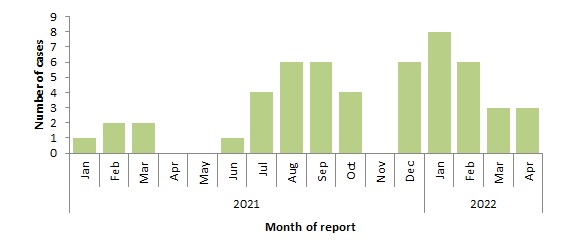
Note: Graph was prepared by the Centre for Immunization and Respiratory Infectious Diseases (CIRID) using data from the WHO EIS postings and the Hong Kong Centre for Health Protection (CHP) press releases. This graph reflects data available as of April 30, 2022.
Figure 2 - Text equivalent
| Month | Cases | |
|---|---|---|
| 2021 | Jan | 1 |
| Feb | 2 | |
| Mar | 2 | |
| Apr | 0 | |
| May | 0 | |
| June | 1 | |
| July | 4 | |
| Aug | 6 | |
| Sep | 6 | |
| Oct | 4 | |
| Nov | 0 | |
| Dec | 6 | |
| 2022 | Jan | 8 |
| Feb | 6 | |
| Mar | 3 | |
| Apr | 3 |
Figure 3. Spatial distribution of human cases of A(H5N6) influenza reported and Lao People’s Democratic Republic from January 1, 2021, to April 30, 2022 (n=52).
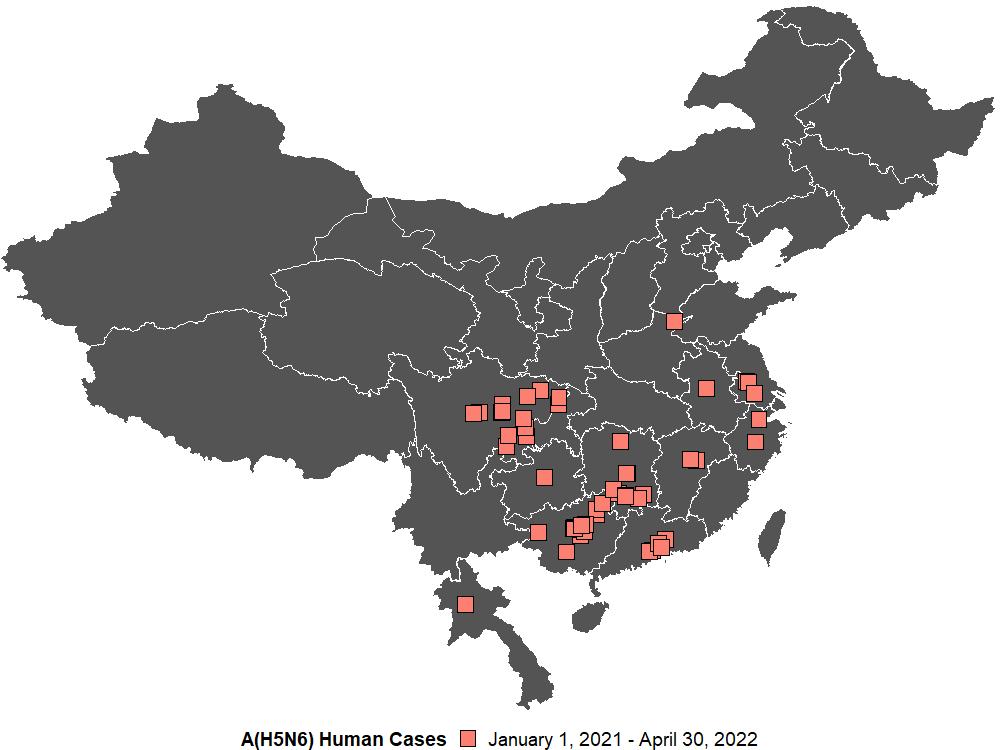
Note: Map was prepared by the Centre for Immunization and Respiratory Infectious Diseases (CIRID) using data from the WHO EIS postings and the Hong Kong Centre for Health Protection (CHP) press releases. This map reflects data available through these publications as of April 30, 2022.
Figure 3 - Text equivalent
- One case was reported out of Yongchuan, Chongqing Municipality.
- One case was reported out of Guizhou Province.
- One case was reported out of Anhui Province.
- Two cases were reported out of Guangxi Zhuang Autonomous Region.
- Two cases were reported out of Chengdu, Sichuan Province.
- One case was reported out of Bazhong, Sichuan Province.
- One case was reported out of Kaijiang, Sichuan Province.
- Two cases were reported out of Tongnan, Chongqing Municipality.
- One case was reported out of Xuanhan, Sichuan Province.
- Three cases were reported out of Guilin, Guangxi Zhuang Autonomous Region.
- One case was reported out of Yibin, Sichuan Province.
- Two cases were reported out of Huizhou, Guangdong Province.
- Two cases were repored out of Dongguan, Guangdong Province.
- One case was reported out of Laibin, Guangxi Zhuang Autonomous Region.
- Two cases were reported out of Chenzhou, Hunan Province.
- Four cases were reported out of Yongzhou, Hunan Province.
- One case was reported out of Changde, Hunan Province.
- One case was reported out of Zigong, Sichuan Province.
- One case was reported out of Nanning, Guangxi Zhuang Autonomous Region.
- Two cases were reported out of Hengyang, Hunan Province.
- One case was reported out of Baise, Guangxi Zhuang Autonomous Region.
- Two cases were reported out of Zhenjiang, Jiangsu Province.
- One case was reported out of Fuzhou, Fujian Province.
- One case was reported out of Yangzhou, Jiangsu Province.
- One case was reported out of Hechi, Guangxi Zhuang Autonomous Region.
- Two cases were reported out of Liuzhou, Guangxi Zhuang Autonomous Region.
- One case was reported out of Jiangxi Province.
- One case was reported out of Puyang, Henan Province.
- One case was reported out of Deyang, Sichuan Province.
Middle East respiratory syndrome coronavirus (MERS-CoV) update
In April 2022, one (1) new MERS-CoV case was reported from Qatar. The case, a 85-year-old male, was exposed to camels prior to illness onset. He was admitted to the hospital for treatment. The case is deceased. No additional details about the case or potential close contacts have been released.
The WHO has confirmed that the 49-year-old from Turabah city, Saudi Arabia, reported in the December 2022 HERP Bulletin with an active status is deceased.
A total of 2,578 laboratory-confirmed cases of MERS-CoV, including 882 deaths, have been reported globally since 2012 by the WHO (CFR: 34%). Two (2) MERS-CoV case has been reported worldwide in 2022. No cases have been reported in Canada.
Figure 4. Temporal distribution of human cases of MERS-CoV reported to the WHO, globally, by month and year, January 1, 2019 to April 30, 2022 (n=296).
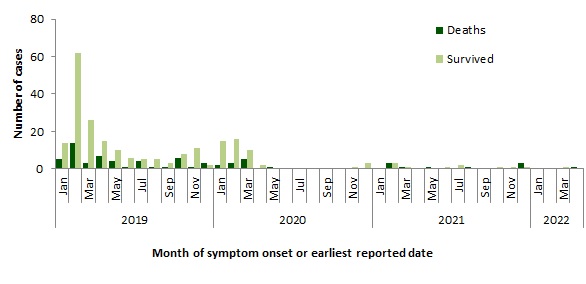
Note: Graph was prepared by the Centre for Immunization and Respiratory Infectious Diseases (CIRID) using data from the WHO Disease Outbreak News and Saudi Arabia’s Ministry of Health. This graph reflects data available as of April 30, 2022.
Figure 4 - Text equivalent
| Deaths | Survived | ||
| 2019 | Jan | 5 | 14 |
| Feb | 14 | 62 | |
| Mar | 3 | 26 | |
| Apr | 7 | 15 | |
| May | 4 | 10 | |
| June | 1 | 6 | |
| July | 4 | 5 | |
| Aug | 1 | 5 | |
| Sep | 1 | 3 | |
| Oct | 6 | 8 | |
| Nov | 1 | 11 | |
| Dec | 3 | 2 | |
| 2020 | Jan | 2 | 15 |
| Feb | 3 | 16 | |
| Mar | 5 | 10 | |
| Apr | 0 | 2 | |
| May | 1 | 0 | |
| June | 0 | 0 | |
| July | 0 | 0 | |
| Aug | 0 | 0 | |
| Sep | 0 | 0 | |
| Oct | 0 | 0 | |
| Nov | 0 | 1 | |
| Dec | 0 | 3 | |
| 2021 | Jan | 0 | 0 |
| Feb | 3 | 3 | |
| Mar | 1 | 1 | |
| Apr | 0 | 0 | |
| May | 1 | 0 | |
| June | 0 | 1 | |
| July | 0 | 2 | |
| Aug | 1 | 0 | |
| Sep | 0 | 0 | |
| Oct | 0 | 1 | |
| Nov | 0 | 1 | |
| Dec | 3 | 1 | |
| 2022 | Jan | 0 | 0 |
| Feb | 0 | 0 | |
| Mar | 0 | 1 | |
| Apr | 1 | 0 | |
